Evolución del Balón en los Mundiales [ESP/ING]

Este 2022 es año mundialista, desde 1930 a la fecha, cada 4 años (salvo en 1942 y 1946, debido a la disputa de la Segunda Guerra Mundial) se disputa la Copa del Mundo, la competición más bonita de ver, esa que está cargada siempre de un clima de festividad y de momentos icónicos en la historia del futbol.
This 2022 is a World Cup year, since 1930 to date, every 4 years (except in 1942 and 1946, due to the Second World War) the World Cup is played, the most beautiful competition to watch, the one which is always loaded with a festive atmosphere and iconic moments in the history of football.
Hoy vamos a dar un repaso cargado de nostalgia al verdadero protagonista del juego en cada Copa del Mundo, el balón, en torno al cual giran un sin numero de disputas legendarias, goles increíbles, derrotas amargas y las más dulces victorias.
Today we are going to take a nostalgic look at the true main character of the game in each World Cup, the ball, around which countless legendary disputes, incredible goals, bitter defeats and the sweetest victories revolve.
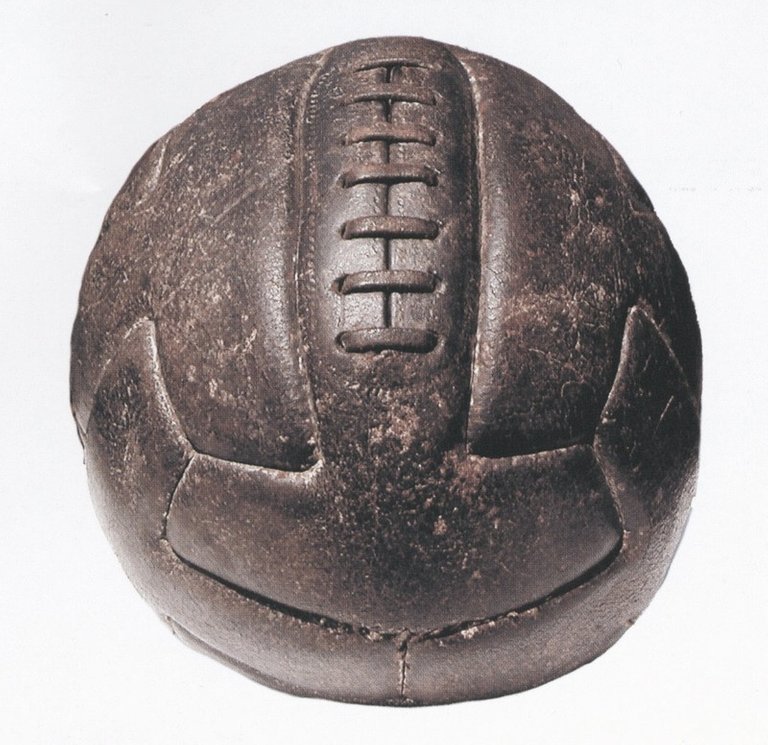
- Uruguay 1930
En Uruguay 1930 se usaron dos balones, el “Tiento” hecho en Argentina y el “Super T” fabricado en Uruguay; la diferencia sustancial entre uno y otro era el peso. En la final, durante el primer tiempo, se usó el esférico argentino, pero en la segunda parte, los uruguayos cambiaron al “Super T”, remontaron el marcador y obtuvieron la Copa.
In Uruguay 1930, two balls were used, the "Tiento" made in Argentina and the "Super T" made in Uruguay; the substantial difference between one and the other was the weight. In the final, during the first half, the Argentinian ball was used, but in the second half, the Uruguayans switched to the "Super T", came from behind and won the Cup.
No había costuras sintéticas ni textiles en ese par de balones; todo cuero animal. La pelota podía llegar a pesar 2 kilos, y cabecearla en la costura externa podía significar el ganarse algunos puntos de sutura en la cabeza.
There were no synthetic or textile seams on that pair of balls; all animal skin. The ball could weigh as much as 2 kilos, and heading it into the outer seam could mean earning a few stitches in the head.

- Italia / Italy 1934
En Italia 1934 se usó “la Federale” un Mundial manchado por el régimen fascista de Benito Mussolini. La costura externa de este balón pasó a ser de algodón. Se seguía usando vejiga animal, jugadores como Monti, Meazza, Schiavio formaron parte del plantel italiano, campeón del mundo por primera vez.
In Italy 1934 "la Federale" was used in a World Cup stained by the fascist regime of Benito Mussolini. The external stitching of this ball was changed to cotton. Animal bladder was still used, players such as Monti, Meazza, Schiavio were part of the Italian squad, world champion for the first time.
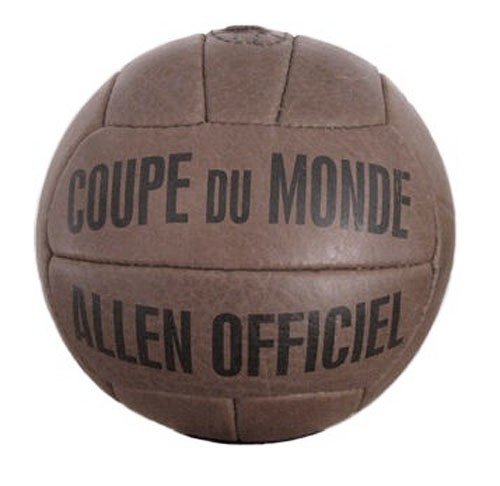
- Francia / France 1938
En el Mundial de Francia 1938, la “Allen” introdujo la válvula como un nuevo elemento del balón. Nos despedimos de la vejiga de porcino y con la novedosa válvula, ya no era necesario desabrochar las costuras externas para poder inflar el esférico. Aún teníamos deformaciones y absorción de agua, para corregir dichos problemas aun faltaría muchísimo tiempo.
At the 1938 World Cup in France, the "Allen" introduced the valve as a new element of the ball. We said goodbye to the pig bladder and with the new valve, it was no longer necessary to unbuckle the external seams in order to inflate the ball. We still had deformations and water absorption, and it would take a long time to correct these problems.
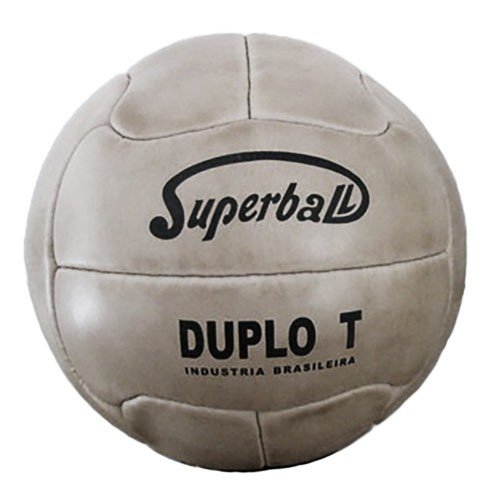
- Brasil / Brazil 1950
La “Superball Duplo T” de Brasil 1950 no presentó grandes cambios en relación a su antecesora. Era un balón más agradable a la vista, eso sí. Las costuras eran mucho más estéticas, y balón se comportaba un tanto mejor en condiciones adversas. Con él, Ghiggia rompería toda lógica y los corazones de todo Brasil en mil y un pedazos con aquel mítico “Maracanazo.
The "Superball Duplo T" of Brazil 1950 did not present great changes in relation to its predecessor. It was a ball that was more pleasing to the eye, of course. The stitching was much more aesthetic, and the ball behaved a little better in adverse conditions. With it, Ghiggia would break all logic and the hearts of all Brazil into a thousand and one pieces with that mythical "Maracanazo".
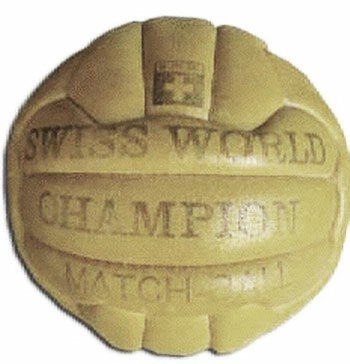
- Suiza / Switzerland 1954
Grandes cambios para Suiza 1954 con la “Swiss World Champion”, se eliminan las costuras externas y se modificó la distribución de paneles, lo que trajo como resultado un balón más esférico; con él, Alemania le dio el gran golpe a la Hungría campeona olímpica que sumaba 33 juegos invicta.
Big changes for Switzerland 1954 with the "Swiss World Champion", the external seams were eliminated and the distribution of panels was modified, which resulted in a more spherical ball; with it, Germany struck a great blow against the Olympic champion Hungary, which had been undefeated for 33 games.
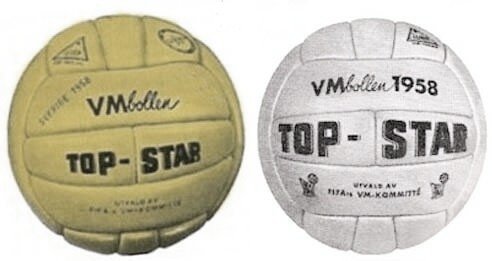
- Suecia / Sweden 1958
El “Top Star” de la Copa Mundial de 1958, en Suecia, fue fabricado por Sydsvenska Läder & Remfabriks que ganó el concurso que emitió la FIFA entre todos los fabricantes de balones del mundo, fue la primera licitación para ser el proveedor oficial del balón mundialista y el comité organizador recibió 102 propuestas siendo el “Top Star” quien se quedara con el honor de presidir la Copa en Suecia.
The "Top Star" of the 1958 World Cup in Sweden was manufactured by Sydsvenska Läder & Remfabriks, which won the contest issued by FIFA among all ball manufacturers in the world. It was the first bid to be the official supplier of the World Cup ball and the organizing committee received 102 proposals, being the "Top Star" the one who got the honor of presiding over the Cup in Sweden.
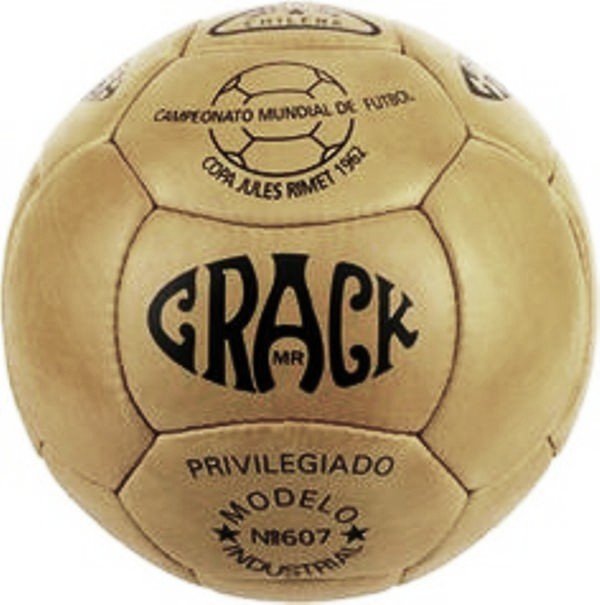
- Chile 1962
El “Crack” de Chile 1962 fue un balón que se utilizando durante 20 años en la nación transandina. Un esférico de 18 paneles que resultaba en un balón menos deformable. La selección anfitriona llegó hasta semifinales, su mejor actuación histórica en una Copa del Mundo.
The "Crack" of Chile 1962 was a ball which was used for 20 years in the Trans-Andean nation. An 18-panel sphere that resulted in a less deformable ball. The host team reached the semifinals, its best-ever performance in a World Cup.
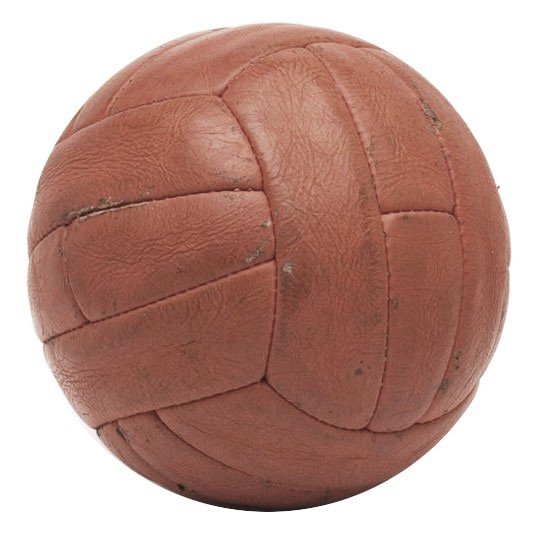
Ingalterra / England 1966
La “Slazenger” de Inglaterra 1966 trajo de vuelta el diseño de los 25 gajos tradicionales y sería el último balón de este estilo. La revolución del marketing y las multinacionales comenzaba a involucrarse en el elemento fundamental para el juego; una nueva era estaba por llegar.
The 1966 England "Slazenger" brought back the traditional 25-panel design and was to be the last ball of this style. The marketing revolution and multinationals were beginning to get involved in the fundamental element of the game; a new era was upon us.
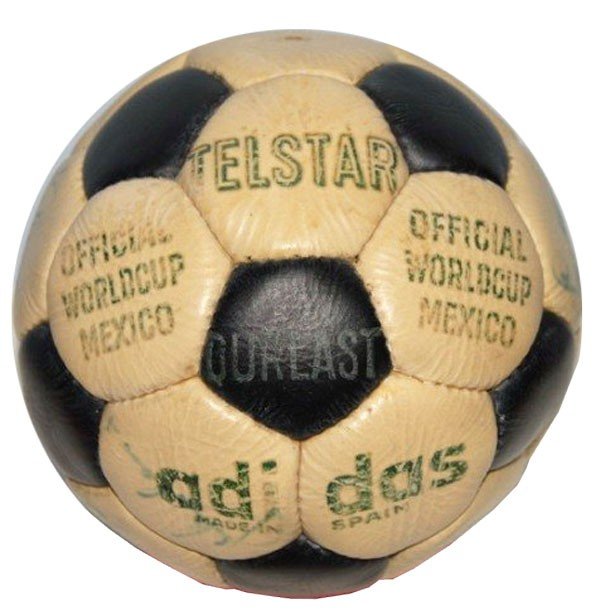
- México / Mexico 1970
El Comienzo de una nueva era, nacía el mítico diseño del icosaedro truncado de 32 gajos que estaría presente desde México 1970 hasta Francia 1998. Un balón enteramente cosido a mano, incluso la válvula. Historia pura, la del Telstar Durlast con el que Adidas comenzaría su camino en los Mundiales.
The beginning of a new era, the birth of the mythical design of the truncated icosahedron with 32 segments that would be present from Mexico 1970 to France 1998. A ball entirely hand-sewn, even the valve. Pure history, the Telstar Durlast with which Adidas would begin its World Cup journey.
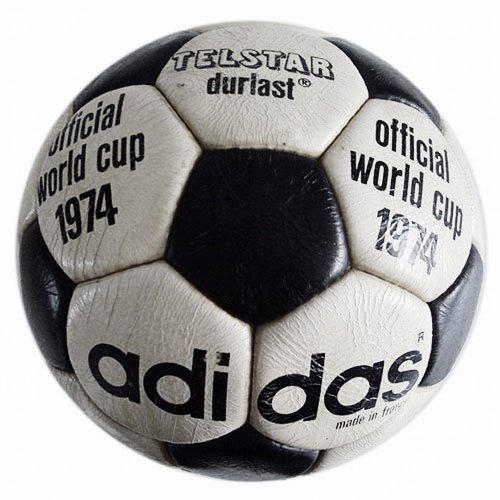
- Alemania / Germany 1974
Para Alemania 1974, el Adidas Telstar Duralast no tuvo muchos cambios, convirtiéndose en el primer balón repetido en la historia de los mundiales y volvería a repetirse en Rusia 2018, eso sí, con un nuevo diseño mucho más innovador.
For Germany 1974, the Adidas Telstar Duralast did not have many changes, becoming the first repeated ball in the history of the World Cup and it would be repeated again in Russia 2018, with a new and much more innovative design.
Adidas se estableció entonces como proveedor oficial de los balones de la Copa del Mundo y lo será, al menos, hasta 2038.
Adidas was then established as the official supplier of the World Cup balls and will remain so until at least 2038.
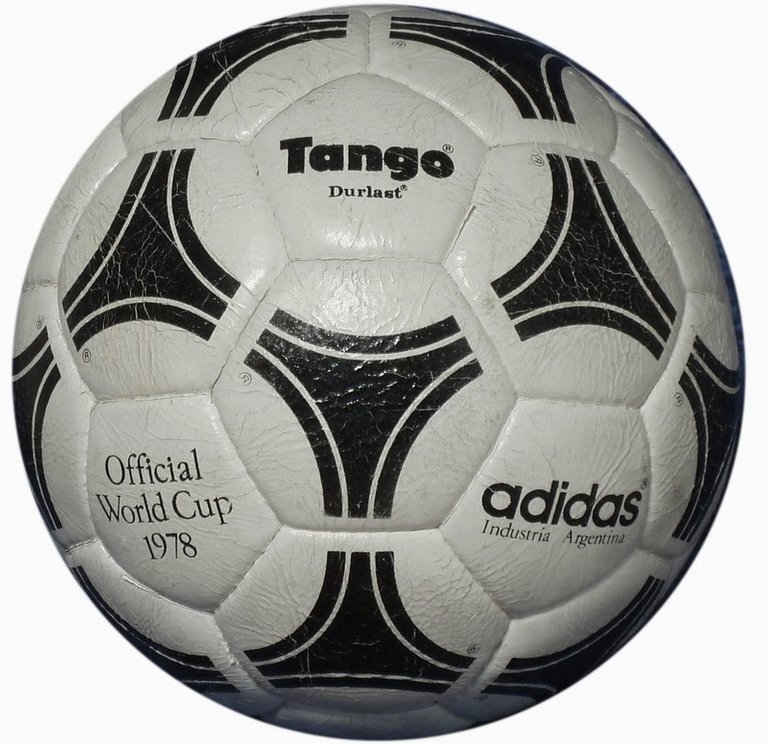
- Argentina 1978
En Argentina le tienen un cariño especial a La “Tango Durlast” que, con una forma de triada, daba 12 figuras redondas. Un estilo que se mantuvo desde 1978 hasta 1998. Si bien se seguía utilizando el cuero animal, comenzaban a notarse sustanciales mejoras en la impermeabilidad.
In Argentina they have a special affection for the "Tango Durlast" which, with a triad shape, gave out 12 round figures. This style was maintained from 1978 to 1998. Even though animal leather was still used, substantial improvements in waterproofness were beginning to be noticed.
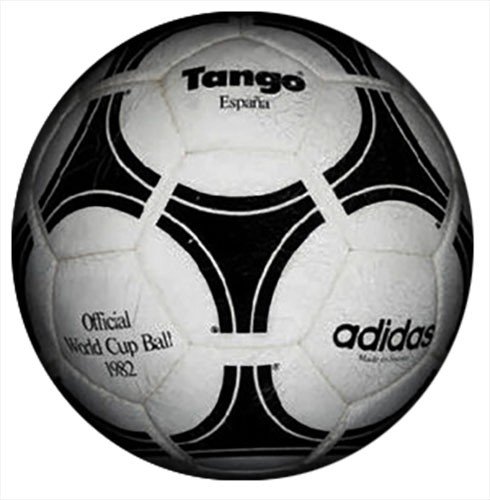
- España / Spain 1982
La “Tango España” utilizada en el Mundial de 1982 no cambiaba en lo estético, pero la llegada del poliuretano impermeabiliza los balones que ya no habrían de adquirir más peso en condiciones húmedas. La transición entre el cuero animal y el material sintético, estaba a punto de consolidarse.
The "Tango España" used in the 1982 World Cup did not change aesthetically, but the arrival of polyurethane waterproofed the balls, which would no longer acquire more weight in wet conditions. The transition from animal leather to synthetic material was about to be established.
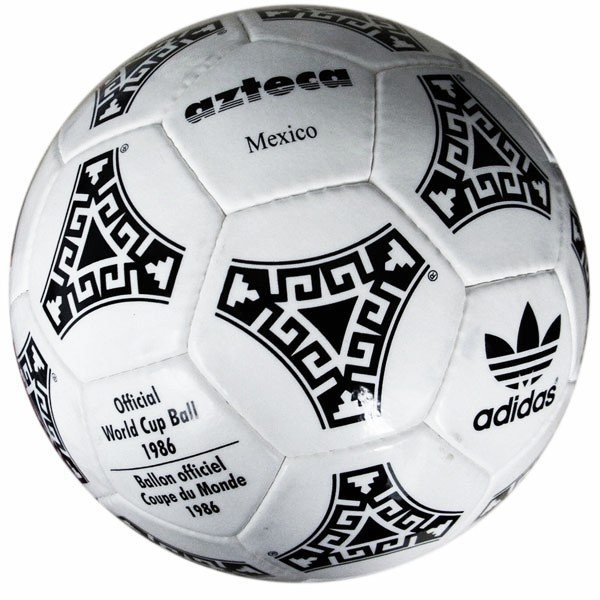
- México / Mexico 1986
En el Mundial de México 1986, el “Azteca” fue el primer esférico 100% sintético y se consiguió una mejor impermeabilidad. Con este balón, es imposible dejar de recordar aquel partido en que Maradona hizo un gol con la mano y descendió al infierno, para cuatro minutos después desparramar a medio equipo inglés y ascender nuevamente al cielo con el “Gol del Siglo”.
In the 1986 World Cup in Mexico, the "Azteca" was the first 100% synthetic ball, and a better waterproofing was achieved. With this ball, it is impossible not to remember that game in which Maradona scored a goal with his hand and descended to hell, only to scatter half of the English team four minutes later and ascend again to heaven with the "Goal of the Century".
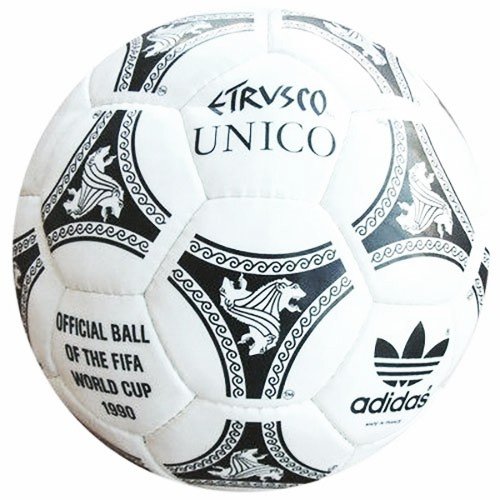
- Italia / Italy 1990
En Italia 1990, el Adidas “Etrusco Único” contaba con una capa interna de espuma negra de poliuretano que le otorgaba mayor velocidad, hecho que lo llevó a ser muy criticado por los guardametas.
At Italy 1990, the Adidas "Etrusco Unico" had an inner layer of black polyurethane foam that gave it greater speed, a fact that led it to be highly criticized by goalkeepers.
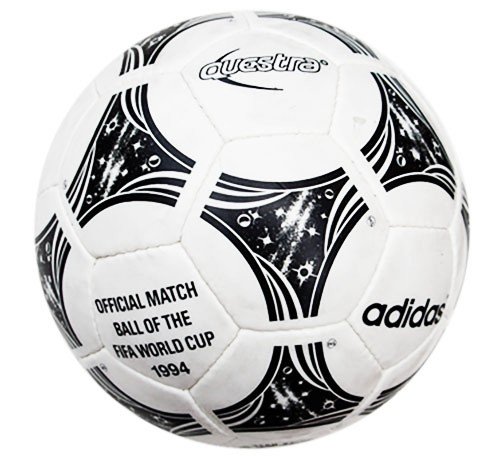
- Estados Unidos / USA 1994
Para la Copa del Mundo de Estados Unidos 1994 Adidas hizo el “Questra” al que le sumó mallas internas de estabilidad con fibras trenzadas, mejorando lo realizado con el “Etrusco”.
For the 1994 World Cup in the United States, Adidas made the "Questra", to which it added internal stability netting with braided fibers, improving on what had been done with the "Etrusco".
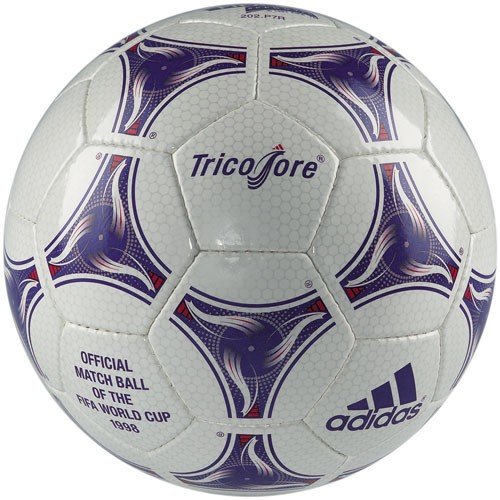
- Francia / France 1998
La Adidas “Tricolore” fue el modelo utilizado para el Mundial de Francia 1998; el primer balón mundialista en agregar colores. Se comienzó a experimentar con nanotecnología, a través de microburbujas llenas de gas, cerradas y muy resistentes, un balón que botaba mucho más.
The Adidas "Tricolore" was the model used for the 1998 World Cup in France; the first World Cup ball to add colors. They began experimenting with nanotechnology, through gas-filled micro-bubbles, enclosed and very resistant, a ball that bounced a lot more.
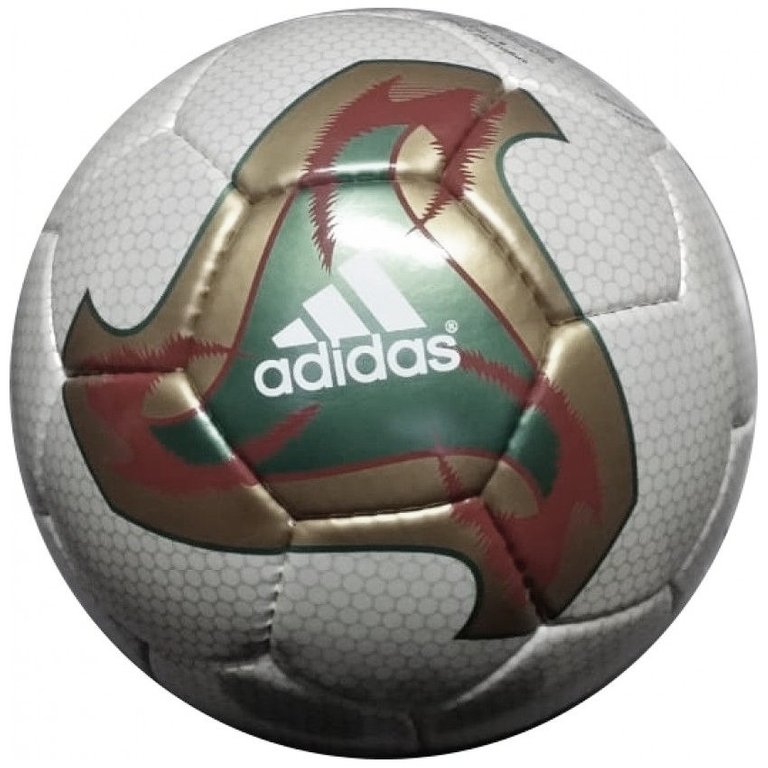
- Corea-Japón / Korea-Japan 2002
Para el Mundial de Corea-Japón 2002, con la Adidas “Fevernova” se hizo un cambio radical en torno al modelo de triada y se utilizó un diseño innovador y disruptivo para la época. Esta fue la última pelota de 32 gajos, con tres capas textiles que le añadían mayor precisión a la trayectoria del esférico.
For the 2002 Korea-Japan World Cup, the Adidas "Fevernova" made a radical change to the triad model and used an innovative and disruptive design for the time. This was the last 32-gauge ball, with three textile layers that added greater precision to the ball's trajectory.
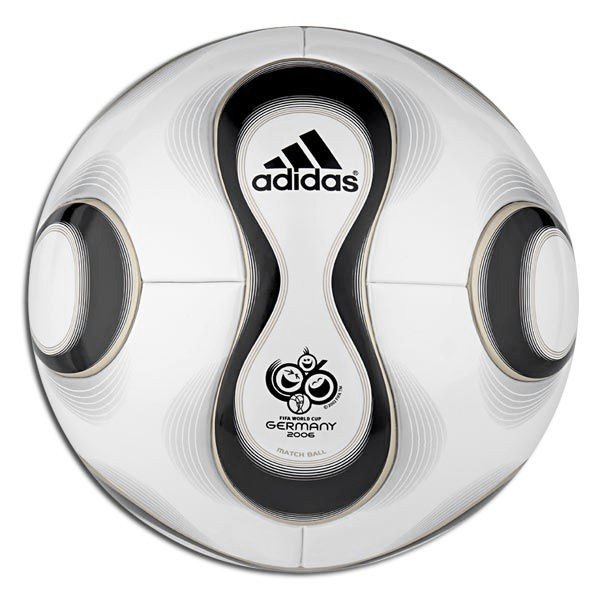
- Alemania / Germany 2006
Para la Copa Mundial de Alemania 2006, la Adidas “TeamGeist+” disminuyó los gajos de 32 a 14 e incorporó tecnología que ofrecía una superficie y textura mucho más suave para rematar. Las hélices termoselladas reemplazaron a los gajos hexagonales, creando un 99% de esfericidad.
For the 2006 World Cup in Germany, the Adidas "TeamGeist+" decreased the number of panels from 32 to 14 and incorporated technology that offered a much smoother surface and texture for finishing. Heat-sealed helixes replaced the hexagonal panels, creating 99% roundness.
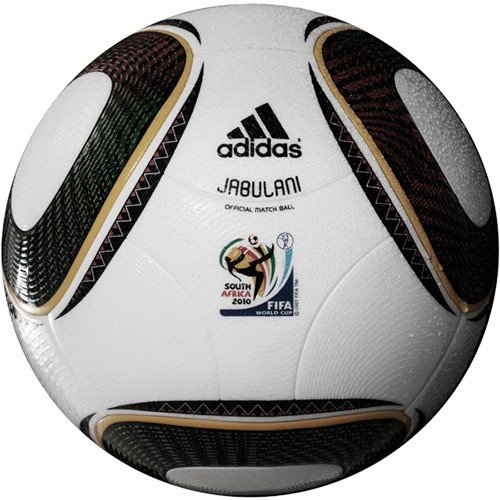
- Sudáfrica / South Africa 2010
En búsqueda de la esfericidad perfecta, Adidas cometió un gravísimo error con el indomable “Jabulani” para el Mundial de Sudáfrica 2010. Se sumó una capa de supercabonato con la intención de mejorar la precisión de los remates, pero se generó el efecto contrario: una trayectoria muy difícil de adivinar. ¡Muy pocos pudieron domarla!
In search of perfect sphericalness, Adidas made a serious mistake with the indomitable "Jabulani" for the 2010 World Cup in South Africa. A layer of supercabonate was added in an attempt to improve the accuracy of the shots, but it had the opposite effect: a trajectory that was very difficult to predict. Very few were able to tame it!

- Brasil / Brazil 2014
Para el Mundial de Brasil 2014, el Adidas “Brazuca” tenía solo seis paneles de poliuretano en una esfera cuasi perfecta, con una vejiga interna de látex. Un balón con alma brasileña con el que la canarinha poco y nada disfrutó de su mundial, cayendo humillada en semifinales por marcador de 1-7 contra Alemania que terminaría siendo campeona del certamen.
For the 2014 World Cup in Brazil, the Adidas "Brazuca" had only six polyurethane panels in a nearly perfect sphere, with an internal latex bubble. A ball with a Brazilian soul with which the Canarinha enjoyed little or nothing of its World Cup, being humiliated in the semifinals by 1-7 against Germany, which would end up being the champion of the tournament.
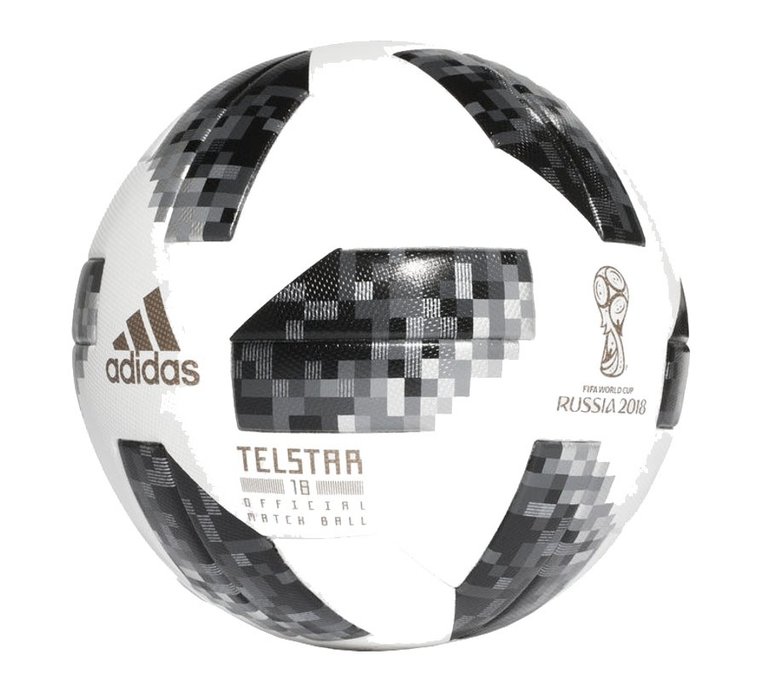
- Rusia / Russia 2018
Para el Mundial de Rusia 2018, se volvió a las bases con el Adidas “Telstar 18”. Un balón con motivos en azul, negro y gris, además de tener un chip incorporado para el almacenamiento datos del juego.
For the Russia 2018 World Cup, it was back to basics with the Adidas "Telstar 18". A ball with blue, black and gray motifs, as well as a built-in chip for storing game data.
Así el breve pero entretenido repaso por los balones que nos han acompañado en cada Copa del Mundo, quedamos a la espera de que la nueva esférica fabricada por Adidas sea Presentada el 31 de marzo durante el Sorteo del Mundial de Qatar 2022.
So, this is the brief but entertaining review of the balls that have accompanied us in each World Cup; we are waiting for the new ball manufactured by Adidas to be presented on March 31 during the draw for the Qatar 2022 World Cup.
✍🏼: Paco Andújar ⚽
https://twitter.com/68andujar/status/1480691719180107776
The rewards earned on this comment will go directly to the person sharing the post on Twitter as long as they are registered with @poshtoken. Sign up at https://hiveposh.com.
¡Enhorabuena!
✅ Has hecho un trabajo de calidad, por lo cual tu publicación ha sido valorada y ha recibido el apoyo de parte de CHESS BROTHERS ♔ 💪
♟ Te invitamos a usar nuestra etiqueta #chessbrothers y a que aprendas más sobre nosotros.
♟♟ También puedes contactarnos en nuestro servidor de Discord y promocionar allí tus publicaciones.
♟♟♟ Considera unirte a nuestro trail de curación para que trabajemos en equipo y recibas recompensas automáticamente.
♞♟ Echa un vistazo a nuestra cuenta @chessbrotherspro para que te informes sobre el proceso de curación llevado a diario por nuestro equipo.
Cordialmente
El equipo de CHESS BROTHERS